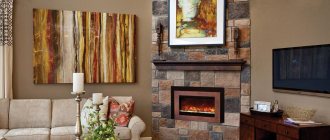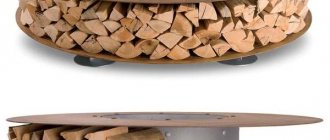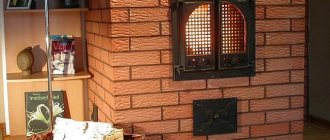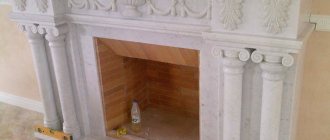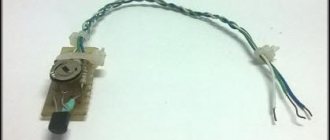An imitation fireplace is a great opportunity to equip a cozy corner with a fireplace in your apartment or house. If previously a stove was a mandatory attribute in any home, today there are a large number of other devices that perform a heating function. At the same time, the installation of such devices is simpler, more affordable and convenient. In this article you can learn more about how to make an imitation fireplace, what devices are used for these purposes, as well as a lot of other interesting, relevant information on this issue.
More about simulation
An imitation of a fireplace can be made with your own hands using improvised means; such a product will decorate and diversify the interior of any apartment, house, office, or entertainment venue.
Imitating a fireplace with your own hands in an apartment means, first of all, creating a cozy, comfortable area. So what is this imitation?
Imitating a fireplace with your own hands means creating and installing a fireplace that will be as similar as possible to a real heating unit, but at the same time there will be no real flame burning in its hearth.
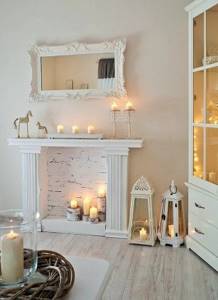
Portal made in a classical direction

Decorating the hearth with lit candles
Important: a decorative hearth in the interior of an apartment or house does not require the construction and installation of a chimney, or the construction of an additional foundation. The design of such an installation can be either the most primitive or more complex, equipped with various modes and effects.
Introduction to the main varieties
An imitation fireplace allows you to install one of the types of heating devices presented:
- You can imitate a fireplace in the interior using an electric hearth. Such stoves can have both a heating function and a number of visual effects. In particular, to give maximum similarity and realism, sound effects are used that imitate the sound of logs crackling in the fireplace. On the visual side, the image of the firebox is complemented by a three-dimensional image of the flame. Also, this effect can be achieved due to the presence of a steam generator built into the design;
- Imitation of a fireplace is also possible using false interior solutions. Such installations consist of one portal and a large fireplace, usually of an open type. In this case, the inside of the portal is decorated at the discretion of the owners. It is important that the accessories located in the firebox are not set on fire. You can decorate the fireplace in the interior with the help of candles, decorative ceramic logs, coals, and candlesticks.

Decorating the firebox using logs and cones

Electric fireplace, framed by a portal with artificial stone trim
Advice: when imitating a fireplace in the interior , do not forget that it should fit perfectly and be in harmony with the other components of the room. A living room or bedroom with a fireplace should not look overloaded. However, the stove itself should not be lost sight of.
What to put inside
No matter how beautiful the fireplace portal may be, without fire, or at least its imitation, it has an unfinished appearance. There are several options:
- Buy an electric fireplace and build a frame around it. Not a bad option, especially since it also performs a heating function (due to the built-in fan heater). But it requires a fairly substantial amount. Especially if there are options such as imitation of firewood crackling and LED backlighting.
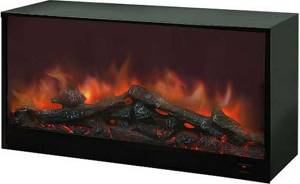
Electric fireplace - simple, but expensive - Place candles inside. Such fireplaces are even called candle fireplaces. When making a portal for such a fire source, it can be made shallow - 15-20 cm - this is more than enough.
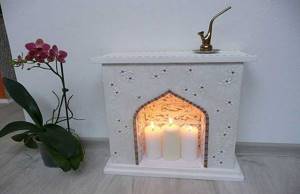
The candle fireplace is definitely decorative. No functional load - Bio-fireplace (also called eco-fireplace). This is a small glass structure in which special biofuel burns without smoke or soot. It is absolutely safe and very decorative. It is still a living fire, albeit without smell or sound. Its downside is the price. For some models, it is comparable to the cost of installing a brick one, with the only difference being that a bio-fireplace does not require a permit.
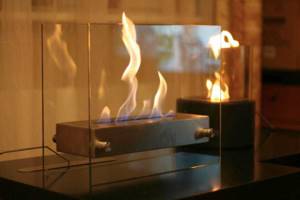
The bio-fireplace can be placed in the made portal - Make something that looks like fire using red, warm white and yellow LED bulbs.
What materials should I use?
Before you make an imitation of fireplaces with your own hands, we recommend that you familiarize yourself with the list of materials from which a decorative portal and hearth can be made:
- A high-quality and durable portal can be built from sheets of metal. However, to work with this material you must have a suitable tool and experience. This high-tech fireplace will fit perfectly into any modern living room;
- You can imitate a fireplace in an apartment using MDF, plywood or chipboard. Such a portal will look equally good in both country and rustic styles;
- A fireplace made of wooden blocks will look perfect in a retro design. At the last stage, you can emphasize the structure of the wood with your own hands by covering it with a special varnish or paint. Wood with an aged effect will also look advantageous. To achieve this effect, a special stain is used;
- A standard variation related to both the classic and loft directions are structures assembled from brick. However, the disadvantages of this option include the heavy weight of the frame and the complexity of construction and installation work;
- You can build a decorative false fireplace, which will look equally good in the interior of a large medium-sized or small living room or room, from sheets of plasterboard. In order to give the structure a certain shape, a metal profile is initially used;
- To create a simulated frame, it is allowed to use materials such as artificial and natural stone. To do this, the elements are simply glued using a special construction adhesive onto a previously prepared wall, partition, or niche.
Also, the finished imitation can be supplemented with a TV above the fireplace. This option fits equally well with modern, high-tech, and classic, loft, and country style trends.
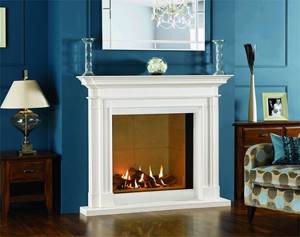
Simple plasterboard frame

Expensive and elegant portals made of natural stone

Using gypsum stucco molding and patterns for decoration: classic
How to build a false fireplace

The simplest designs are made of cardboard
In order for the structure to be erected correctly, at the first stage of preparatory work, you will need to familiarize yourself with the basic rules and requirements for this process:
- Select the room and the exact location for installation and placement of the structure;
- Make a detailed diagram that will display parameters such as: height, width, shape and depth of the decorative unit;
- If bricks will be used to assemble the frame, they must first be placed in water. This is necessary so that all excess air is removed from them;
- Use a building level when working, and start assembly from the bottom corner. The inside of the combustion hole is also additionally lined with heat-resistant materials, such as ceramic tiles or stone;
- Next, you can decorate the niche at your discretion or install an electric fireplace in it.
You can also watch the video in the article on how to make a false fireplace with your own hands:
Rules and recommendations
A ceramic chimney, as well as other steel and sandwich systems, must meet a number of requirements and criteria, which you can read below:
- The pipe must be completely safe. Choose material and fittings that will withstand high temperatures well, with a high level of heat resistance and tightness. Such pipes should not melt, deform or collapse;
- Pay attention to such a parameter as: gravity. The value is calculated per linear meter. In each case, this indicator is individual. It depends on the shape, size, cross-section, materials and other characteristics of the chimney. It is preferable to buy pipes with a smooth surface and a round shape;
- Please ensure that maintenance and repairs are carried out infrequently and quickly enough. To do this, it is necessary to ensure unobstructed access to the structure. Cleaning should be carried out without disassembling the pipes. Much depends on the service life and material of manufacture of the tubular elements;
- The quality of work is primarily determined by the durability and characteristics of the selected material. It is important that it has good resistance to the environment in which soot is formed and is regularly exposed to combustion products. The material should not collapse, lose its strength or oxidize. To prevent excess condensation from forming on the inner surface of the pipe, it is important to properly insulate it using non-combustible materials.
What materials will be needed
To assemble and construct a standard type of decorative frame with our own hands, we will need the following materials and tools:
- Bricks (silicate or fireproof can be used);
- Masonry mortar;
- Fire-resistant material that will be used to line the inside of the fireplace;
- Building level;
- Hearth (can be electric or run on biofuel);
- Tools for masonry, cutting, construction;
- Decorative facing material (heat-resistant).
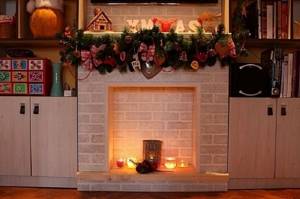
Decorative fireplace made of cardboard
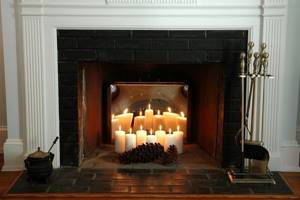
A mirror in the hearth makes the fireplace visually larger
Important: since brick portals are quite bulky and massive, it is better to place them in rooms with an area of 25 square meters or more. For small rooms, frames made of plasterboard or MDF are suitable.
Stages of work execution
Regardless of what material the heating unit will be built from, all work is divided into the following stages:
- Making the base and finishing it with simple materials;
- Insulating the installation, sealing seams, lining with fireproof materials in places where the structure is heated the most;
- Placement of the combustion chamber (if available);
- Finishing lining and decoration of the framing surface.
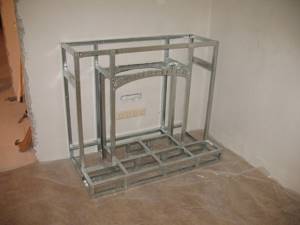
Creating a frame for a false fireplace
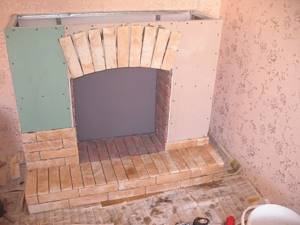
DIY plasterboard fireplace
Interesting to know: in addition to the size and shape of the heating installation, you can choose its location. The fireplace can be corner, located near the wall, in the center of the room, built into a pre-prepared niche, or fixed using special brackets directly on the wall or partition.
Important: if you want to assemble a plasterboard fireplace with your own hands, first of all apply all the marks to the wall and floor, and then assemble the main skeleton from metal profiles. The next step will be covering the frame with sheets of plasterboard. It can be secured with dowels or self-tapping screws. After this, all seams and joints are rubbed with putty material, the surface is prepared and leveled. At the last stage, the device is lined with fireproof materials (don’t forget about the inside of the fireplace).
When choosing a hearth for a decorative fireplace, try to put together all the characteristics and find them in the model of one device. For example, fireplaces that only have a heating function are more affordable. More expensive ones include the ability to adjust the power level, sound, visual effects, can be synchronized with PCs, tablets, smartphones, and can also be controlled remotely.
Beautiful fireplace made of plasterboard with your own hands: photo

In this case, the plasterboard construction will be the most costly in terms of budget. To build it you will need:
- profiles;
- metal scissors;
- drywall;
- spatulas;
- drywall screws;
- roulette;
- dowels in a concrete wall;
- screwdriver;
- primer for drywall;
- construction knife with several spare blades;
- painting mesh;
- screwdrivers;
- serpyanka;
- decorated elements made of stone, tiles, painted or sculpted;
- putty;
- sandpaper;
- drill with drills.
Before construction, the sketch dimensions are transferred to the base so that the building is level. Stages:
- The main profile structure is fastened with dowels, ensuring that the lines are even in relation to the wall.
- The guide profiles should be fastened according to the scheme: 2 vertically and 2 horizontally. The lower one, located horizontally, sets the height of the parapet.
- After the outline has been marked, a profile is attached that will define the combustion chamber.
- The base of the fireplace is built on the floor so that the racks in front are at a distance of the width of the firebox window, where the depth of the structure will be marked. The profiles at the front are fastened horizontally to the rear ones by jumpers.
- An arc for the arch is bent from the metal structure under the plasterboard, on the sides of which it is necessary to make small cuts with an indentation of 2 cm. Next, all profiles should be secured with self-tapping screws.
On a note!
If necessary, jumpers should be added (for better rigidity).
For perfect horizontal evenness, a bar is used; a weight is hung horizontally, which is suspended on a strong thread.
To finish, you need to cut the drywall with a construction knife, based on the drawing. To create more complex parts, you need to use graph paper. All cut out plasterboard parts are fastened together with self-tapping screws at a distance of 15 cm from each other.
If you wish, you can disguise parts of the heating system inside, but first you need to make sure that the structure can withstand the heat.
When cutting out shapes, the edges of the parts are cut at an angle of 45°, the end should be 5 mm. These edges will become the joints onto which the reinforced tape is glued. After manufacturing all the parts, the structure must be treated with a double layer of primer. The second coat of primer is applied after the first has dried. To achieve a neat look, the fastening points are covered with putty. When the putty is completely dry, in good lighting, dust particles and irregularities are removed using sandpaper. The final step is to sweep away all the dust and apply an additional layer of primer. After painting, the fireplace is ready.
